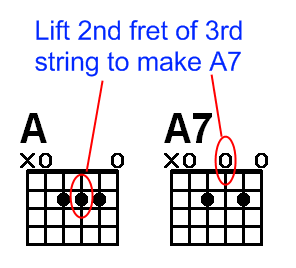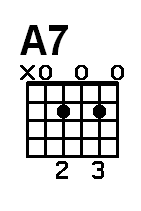A7 Chord
Lesson Goals:
♦ Learn proper fingering for the A7 chord
♦ Play the chord clearly
♦ Visualize the chord pattern
The "A7" chord can be used like other 7th chords - as a passing chord, such as when it follows an "A major" chord, to lead into the next major chord of the progression - or simply as a substitute for an "A" major chord in a particular song. It is really up to the discretion of the songwriter how it is used.
The "A7" chord is formed by placing the 2nd finger of the 2nd fret of the 4th string, and the 3rd finger on the 2nd fret of the 2nd string.
Let's take a look at a comparison between the "A7" chord and it's parent, the "A major" chord.

Notice that, like most "major chord" to "7th" chord changes, there is only one difference between the two chords. The note on the 2nd fret of the 3rd string on the "A major" chord is now lifted off and played open in the "A7" chord.



